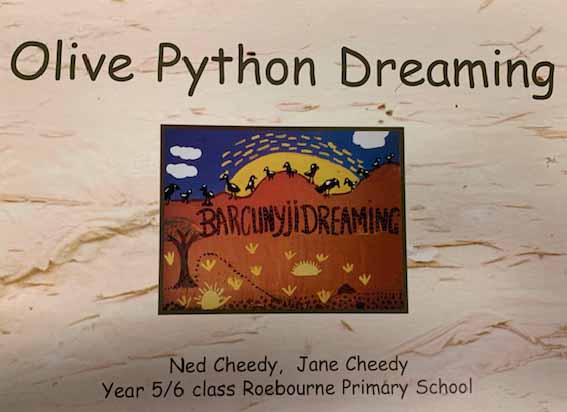The Year 5/6 class at Roebourne School created a series of ten paintings for their classroom, in response to elder Ned Cheedy's telling of the Dreaming story of the olive python that was told to him.
Marrga (Praying Mantis) and Bargumyji (Olive Python) have a feud. Marrga makes Bargumyi become sluggish and a night hunter in rocks around water. The colours used in the paintings, the details and the line of the landscape has been carefully controlled to maintain a pleasing overall book design : the python’s red eyes transformed by his ill-timed bite of the ghost gum are especially memorable. Context is everything in this story – its abrupt ending which may not sit with English listeners easily but is culturally correct. The backgrounds for cover and explanatory text pages are scanned paperbark, and a pronunciation list is included.
The authors state: 'It is our hope that this book will assist students (and their teachers) develop a better understanding of the relationship between language and its social and cultural context; language and identity, and the importance to all people of their own linguistic heritage.' The design of the tri-lingual text (Yindjibarndi; Standard Australian English; Aboriginal English) works towards achieving that hope. The three languages are in different colours, spaced on the page to make reading easier, and to not privilege one language over another. Slashes are used between words in Aboriginal English to indicate the rhythm needed when reading - 'Dat fella Marrga/ e bin go lookin/an lookin an lookin for meat. Praying Mantis went hunting, looking everywhere for meat.'
The additional notes in the book do not hinder the enjoyment of the book as a picture book readaloud. The notes by the creators detail the process of gathering content, editing and publishing the book, along with the protocols and consultations necessary. It is a master class in how to produce a community book.

